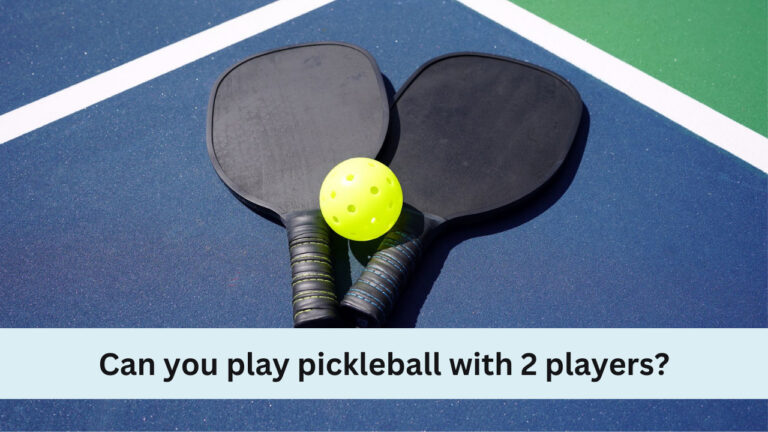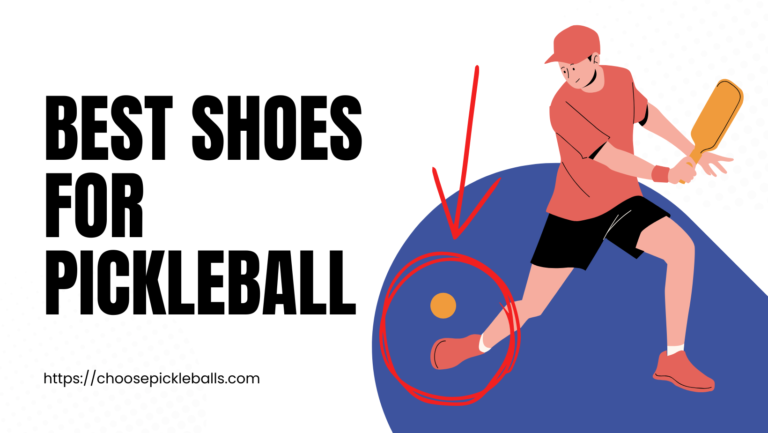How do you keep score in pickleball doubles – Basic Guide (2024)
In the world of pickleball doubles, understanding how do you keep score in pickleball doubles is critical to enjoying this fast-paced and exciting sport. Whether you are new to the pickleball game or an experienced player, it’s crucial to keep track of the score correctly. In this article, we’ll explore the ins and outs of how to keep score in pickleball doubles, ensuring you’re always on the winning side.
Pickleball doubles is becoming more and more popular as a result of its increased accessibility. Some racquet sports have faced criticism for having highly complex and confusing scoring systems, at least to non-avid fans of the sport. One of those sports where players really need to know the rules of the game is pickleball, especially while playing doubles.
In pickleball doubles, the scores are referred to as the server score, receiver score, and server number in that order. When a pickleball doubles match starts, the score is 0,0,2. To ensure fair play, the serving and receiving teams must adhere to specific regulations at all times. It can occasionally take time for new players to understand the pickleball regulations and scoring system. Then, how are scores kept in pickleball doubles?
Before we get into the nitty-gritty of scoring, it’s essential to understand the roles of the serving and receiving teams in a pickleball doubles match.
- Serving Team: In pickleball doubles, each team consists of two players. The team that serves them is referred to as the serving team. The right-side player of the court is the one who initiates the serve, underhand, and diagonally to the opposite diagonal court.
- Receiving Team: The opposing team, which stands on the opposite side of the court, is the receiving team. Their primary goal is to return the serve effectively and eventually win the rally to become the serving team.
How do you keep score in pickleball doubles
Starting Score
At the beginning of a pickleball doubles match, the score is always set at 0-0, and it is the serving team’s prerogative to serve first. The right-side player of the court begins the game by serving the ball underhand to the diagonally opposite service court.

Points and Side Outs
Points are earned during a pickleball doubles game, and it’s crucial to understand how they are accumulated.
- Points: Points in pickleball doubles are earned one at a time, and they are scored when the serving team wins a rally. This means that the serving team’s objective is to win points, while the receiving team aims to prevent them from doing so.
- Side Outs: A side out occurs when the serving team commits a fault, causing them to lose their serve. A fault could be the ball going out of bounds, the serve not reaching the opposite service box, or the serving player stepping on or into the non-volley zone during the serve.
Scoring System
To maintain clarity during a game, understanding the scoring system is vital. In pickleball doubles, the score is always called out in the following format: “X-Y,” where X is the score of the serving team, and Y is the score of the receiving team. This format ensures that players and spectators can easily track the game’s progress.
Winning the Game
Knowing how to win a game is crucial, as it gives players a clear objective. In standard pickleball doubles games, the winning team is the first to reach 11 points. However, variations exist where games are extended to 15 or 21 points. In any case, the game must be won by a team that is ahead by at least two points. For instance, if the score is 11-10, the game will be continued until it leads by two points, such as 12-10, or it may be 13-11.
Switching Sides
Switching sides during a game is a strategic aspect of pickleball doubles. In official pickleball matches, players switch sides of the court when the sum of both teams’ scores equals six. This rule ensures that external factors like the sun and wind affect both teams equally and maintain fairness throughout the game. For instance, you’d switch sides when the score is 3-3, 5-1, or 2-4.
What is the Pickleball double-game procedure?
In pickleball doubles, the procedure follows a set of steps to ensure that the game is played reasonably and efficiently. Here’s a summary of the typical pickleball doubles game procedure:
- Coin Toss or Paddle Spin: Before the game begins, a coin toss or paddle spin is often used to determine which team will have the option to serve or receive.
- Starting Serve: The game starts with one member of the serving team (the right-hand player) standing behind the baseline and serving the ball diagonally to the opposite service court. The receiving team stands on the other side, and the player who is diagonal from the server receives the serve.
- Serve and Rally: The serving team must let the ball that served bounce one before returning it (the two-bounce rule is not in effect for the serve). After the initial bounce, both teams engage in a rally, trying to win the point by hitting the ball over the net and into the court of the opponent.
- Scoring Points: The serving team scores points if they win a rally. The serving team’s score is always announced first, followed by the receiving team’s score. Points are gained one at a time during a rally.
- Faults and Side Outs: If the serving team commits a fault (e.g., the ball goes out of bounds, doesn’t reach the opposite service box, or the serving player steps into the non-volley zone), they lose their serve and call it side-out. The receiving team then becomes the serving team.
- Winning the Game: In a standard pickleball doubles game, the winning team is the first to reach 11 points, but variations can extend the game to 15 or 21 points. However, the game must be won by a team that is ahead by at least two points. For instance, if the score is 11-10, the game will be continued until it leads by two points, such as 12-10, or it may be 13-11.
- Switching Sides: In official pickleball matches, players switch sides of the court when the sum of both teams’ scores equals six. This ensures fairness as external factors, like sun and wind, affect both teams equally. Side switching can occur when the score is 3-3, 5-1, or 2-4, for instance.
- Game Conclusion: The game continues with this process until one team reaches the predetermined number of points (e.g., 11, 15, or 21) and is ahead by at least two points. The first team to achieve this is declared the winner of the game.
- Best of Three (if applicable): In tournament play or more formal settings, pickleball doubles matches are often played as a “best of three games.” The team that wins two out of three games is declared the match-winner.
- Understanding the pickleball doubles game procedure is crucial to enjoying the game and participating competitively. It’s essential to follow these steps to ensure a fair and enjoyable match for all players involved.
- The Sequence In pickleball doubles, scores are called out in a particular sequence, which is designed to keep the game balanced and competitive. The sequence is, The score of servers, The score of receivers, and The score of the number can be one or two.
- Initial Score: At the beginning of the game, the score is set at zero for both teams. However, there is a unique aspect to the initial score – the server number. It starts at two. This initial setup is essential as it ensures that the serving team doesn’t have an undue advantage right from the start.
- The Server Number: The server number is a distinct element in pickleball doubles, and it can only be one or two. This relates to the player responsible for serving during that specific service turn. Since each team consists of two players, the server number becomes a crucial identifier for the current server.
- Dynamic Server Number: Here’s where it gets interesting the server number is fixed for only part of the game. It’s applicable for the ongoing service turn only. When the serving team regains the serve after a side out or a fault, the player standing on the right side of the court becomes server number one for that service turn. If server number one commits a fault, the role of server number shifts to its partner, server number two, for the next service.
This dynamic assignment of the server number ensures that both players on a team have their fair share of serving opportunities. It adds a layer of strategy and fairness to the game.
FAQ
What are the critical differences between pickleball singles and pickleball doubles?
In single, each player plays on their own, In doubles, there are two players on each team. Doubles often involve more teamwork and strategy, while singles may focus more on individual play.
What is the purpose of the non-volley zone (kitchen) in pickleball?
The non-volley zone (NVZ), often called the “kitchen,” is a seven-foot area on both sides of the net. The purpose is to prevent players from standing too close to the net and volleying the ball, which could lead to quick, unreturnable shots. This rule encourages longer rallies.
How do I determine who serves first in a pickleball game?
Typically, a coin toss or paddle spin is used to determine which team will have the option to serve or receive first. The winner of the toss gets to make the choice.
Can you explain the concept of rally scoring mentioned in the article?
Rally scoring means that points are scored on every rally, regardless of the serving team. This rule speeds up the game and keeps the action intense, making every point crucial.
For the latest updates follow us on Google News:






![What shoes to wear for pickleball - An Expert Analysis [2024 guide] 7 What shoes to wear for pickleball - An Expert Analysis [2024 guide]](https://choosepickleballs.com/wp-content/uploads/2024/01/ghi-pickleballshoe-64763441ed1fd-768x384.jpg)

3 Comments
Comments are closed.